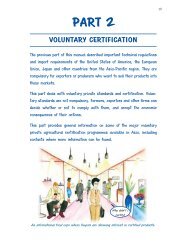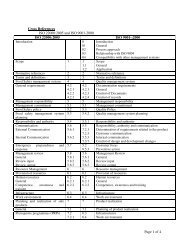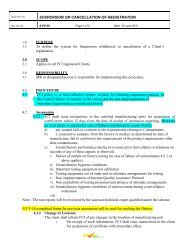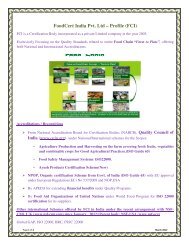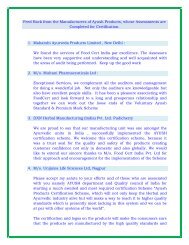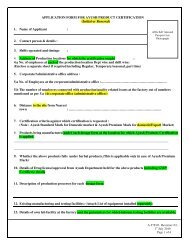Standard for Good Field Collection Practices - NMPB
Standard for Good Field Collection Practices - NMPB
Standard for Good Field Collection Practices - NMPB
Create successful ePaper yourself
Turn your PDF publications into a flip-book with our unique Google optimized e-Paper software.
ANNEX A<br />
DEFINITIONS OF THE TERMS USED IN THIS STANDARD<br />
1. Chemotype: Plants of the same species that is chemically different but otherwise<br />
indistinguishable.<br />
2. Collector: Any person who harvests the medicinal plant produce from any live or dead<br />
medicinal plant species as part of his livelihood or <strong>for</strong> trade.<br />
3. Contamination: The undesired inclusion of impurities of biological or non-biological<br />
origin into or onto medicinal plant produces during harvesting, processing, drying,<br />
packaging, storage or transport.<br />
4. Cross-contamination: Contamination of medicinal plant produce with any other produce<br />
during harvesting, processing, drying, packaging, storage or transport.<br />
5. Foreign Matter: Any matter found with medicinal plant produce, other than the<br />
medicinal plant produce itself. This also includes parts of the same medicinal plant other<br />
than the officially accepted plant part or parts.<br />
6. Genotype: The genetic constitution (the genome) of a cell, an individual or an organism or<br />
Phenotypically dissimilar species with minor mutation when identify through DNA profiling or<br />
genotypes.<br />
7. <strong>Good</strong> <strong>Field</strong> <strong>Collection</strong> <strong>Practices</strong>- The <strong>Good</strong> field collection practices <strong>for</strong> medicinal<br />
plant produce are practices that ensure proper quality of the produce while maintaining<br />
sustainable collection of wild medicinal plants.<br />
8. Herbal Formulation 1 : Herbal preparation obtained by subjecting the medicinal plants<br />
produce to treatments like – extraction, distillation, fractionation, purification,<br />
concentration, fermentation and blending. These include comminuted or powdered herbal<br />
drugs, tinctures, extracts, essential oils, expressed juices and processed exudates. Herbal<br />
<strong>for</strong>mulation may be food, dietary supplement, medicine or a cosmetic preparation.<br />
9. Manufacturer: A company or individual producing herbal <strong>for</strong>mulations or extracts or<br />
active compounds using medicinal plant produce as the source material <strong>for</strong> such products.<br />
10. Medicinal Plant: Any plant species including fungi, algae, lichen, fern, which is entirely<br />
or partly used, either alone or in combination, <strong>for</strong> therapeutic benefit or maintenance of<br />
health in humans, animals or both.<br />
11. Medicinal Plant Produce: Any plant material - whole, fragmented or cut, usually dried<br />
but rarely fresh, obtained from a medicinal plant species, used <strong>for</strong> further preparation of<br />
Page 28 of 44



